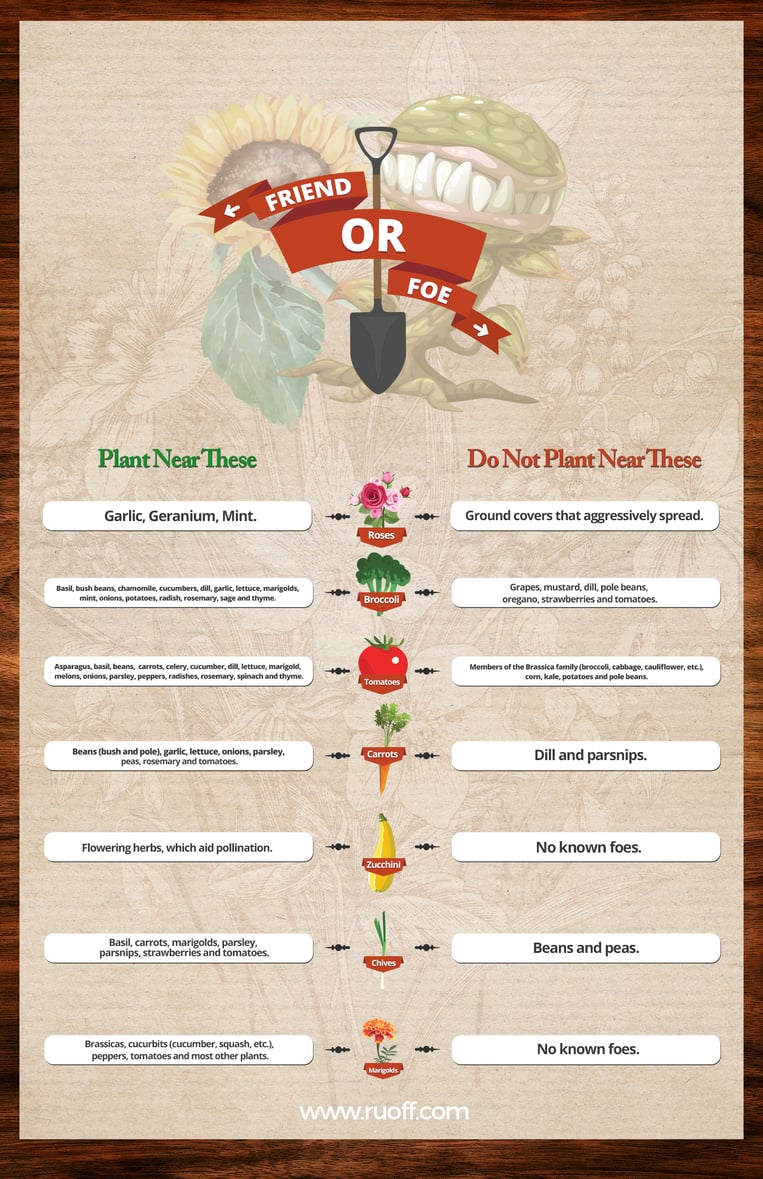Nancy Crowe
Nancy Crowe
If you don’t have a plentiful, pest-free garden, it could be that your plants are working against each other. Or perhaps they just aren’t teamed up as well as they might be for optimum productivity.
Sound like your last staff retreat? Plants, like people, are beautifully diverse and complex, and some combinations work better than others. Gardeners can make these differences work for them.
Companion planting is based on the belief that certain plants benefit others when they’re planted together or near each other. Plants can naturally protect one another from pests or suppress disease, reducing or eliminating the need to use chemicals. Conversely, some plants can suppress or even kill others with chemicals they secrete into the soil, as with the black walnut tree.

Winning Combinations
Here’s a sampling of popular garden picks with a few tips about their favorite and least favorite companions:
Tomatoes
Tomato and basil go together in the garden as well as on the plate; growing basil about 10 inches from tomatoes increases the yield of the tomato plants, according to Vegetable Gardening Life.
Plant near: Asparagus, basil, beans, borage, carrots, celery, cucumber, dill, lettuce, marigold, nasturtium, melons, onions, parsley, peppers, radishes, rosemary, spinach and thyme.
Don't plant near: Members of the Brassica family (broccoli, cabbage, cauliflower, etc.), corn, kale, potatoes and pole beans.
Marigolds
Some people swear by marigolds as border plants for keeping bunnies at bay, though Iowa State University says chicken wire or hardware cloth is more effective for this purpose. However, marigold roots are said to repel root-attacking nematodes, the University of Florida says.
Plant near: Brassicas, cucurbits (cucumber, squash, etc.), peppers, tomatoes and most other plants.
Don’t plant near: No known foes.
Roses
These classic beauties have a reputation for being high maintenance, but they don’t have to be in a bed by themselves in order to thrive.
Plant near: Garlic, geranium and mint “send pests packing,” says Heirloom Roses.
Don't plant near: Ground covers that aggressively spread.
Carrots
Carrots need nitrogen in the soil, which beans provide. To return the favor, onion, parsley and rosemary repel the carrot fly.
Plant near: Beans (bush and pole), garlic, lettuce, onions, parsley, peas, rosemary and tomatoes.
Don’t plant near: Dill and parsnips
Chives
This popular perennial herb is tasty and easy to grow, but it will spread like crazy if you let it go to seed. Pinch off the flowers and it will be a much better neighbor. Chives are said to keep aphids off tomatoes, mums and sunflowers.
Plant near: Basil, carrots, marigolds, parsley, parsnips, strawberries and tomatoes.
Don’t plant near: Beans and peas.
Broccoli
Sara Alway, author of the humorous Soil Mates: Companion Planting for Your Vegetable Garden, pairs this green floret-filled member of the brassica family with rosemary. Rosemary repels broccoli’s archenemy, the cabbage moth, and loves broccoli’s “sweet nutritious side.”
Plant near: Basil, bush beans, chamomile, cucumbers, dill, garlic, lettuce, marigolds, mint, onions, potatoes, radish, rosemary, sage and thyme.
Don't plant near: Grapes, mustard, dill, pole beans, oregano, strawberries and tomatoes.
Zucchini
Want to grow a little zucchini? Be prepared to get a lot.
Plant near: Flowering herbs, which aid pollination (although the herbs have more flavor if you don’t let them flower).
Don’t plant near: No known foes.
Keep In Mind
There is a lot of information available about companion planting, and even the most trusted sources may conflict with one another.
General information on how close to plant companions or how far to separate garden foes can be difficult to find. It really depends on the specific plants involved and how they benefit or detract from each other. Try a search such as such as “planting broccoli and tomatoes” for guidance.
Do your due diligence, but don’t be afraid to experiment to discover what works for your garden. Nature is not static, and everyone’s research is ongoing.
.png?width=375&height=150&name=MicrosoftTeams-image%20(63).png)
